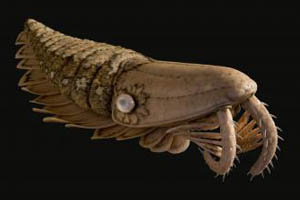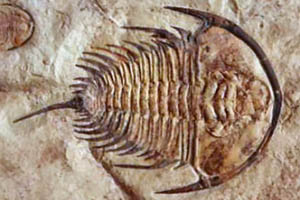Early Cambrian (542- 513 Million Years Ago)
At the beginning of the Cambrian period, only small sponges and molluscs were present. They evolved from more primitive animals in the Pre-Cambrian. Pre-Cambrian organisms were mostly composed of individual cells or occasionally organized into biological colonies, but some were sponges and some may have been worms.
Although life had already been evolving for millions of years, in the Cambrian we see complex organisms that resemble modern life for the first time, in a rapid explosion of growth and diversification. The Early Cambrian is distinguished by some important events in the fossil record.
542-528 MYA: The first brachiopods (marine animals that have hard shells on the upper and lower surfaces) and archaeocyatha (reef-building organisms) appeared.
525-520 MYA: The Chengjiang fossil site in China dates to this time and provides the earliest appearance of diverse, soft-bodied animals.
521-515 MYA: Trilobites, a highly successful and diverse class of arthropods appeared.
515-510 MYA: The Guanshan fossil site in China dates to this time and fills the gap between the early Cambrian animals and most signature Middle Cambrian fossils such as the Burgess Shale animals.
All life in the Cambrian was aquatic life. Nothing had evolved yet to live on land. It was a worldwide phenomenon, with fossils found all around the world today, including the United States, Canada, China and Siberia.
The end of the Early Cambrian is marked by an extinction of many species. Some 83% of types of hard-shelled or -bodied animals did not survive into the Middle Cambrian.
Animals of the Early Cambrian
Haikouichthys (~535 MYA)
 Haikouichthys is an important genus of animal because it is one of the earliest chordates (animals with backbones). It resembles a jawless fish but does possess enough features to be included with fish. It has a distinct head with at least six sets of gills, a distinct tail and a prominent dorsal fin. It was first found in the Qiongzhusi Formation in China.
Haikouichthys is an important genus of animal because it is one of the earliest chordates (animals with backbones). It resembles a jawless fish but does possess enough features to be included with fish. It has a distinct head with at least six sets of gills, a distinct tail and a prominent dorsal fin. It was first found in the Qiongzhusi Formation in China.
Chordates
Chordates are an important phylum to scientists because we humans belong to this phylum! Our backbone is a trait of this group. Our closest relatives in the Cambrian were other chordates like Haikouichthys.
Anomalocaris (~525 MYA)
 Anomalocaris was a unique phylum of animal not quite like any living animals, but is considered an ancestor to arthropods. It was by far the largest animal to swim the Cambrian seas and is considered a predator and scavenger. The largest specimen is over three feet in length. It had at least eleven pairs of overlapping fin-like appendages that it used to propel itself through the water, and two distinctive long feeding appendages covered with spines that it used to crush prey or pull them into its pineapple-ring shaped mouth lined with barbs. A long-standing view holds that Anomalocaris fed on hard-bodied animals, including trilobites. It was first discovered in the Burgess Shale formation in Canada. Anomalocaris specimens are known from Australia, Europe North America and the Chengjiang fossil site in China. Many large well-preserved specimens have also recently been found in Morocco.
Anomalocaris was a unique phylum of animal not quite like any living animals, but is considered an ancestor to arthropods. It was by far the largest animal to swim the Cambrian seas and is considered a predator and scavenger. The largest specimen is over three feet in length. It had at least eleven pairs of overlapping fin-like appendages that it used to propel itself through the water, and two distinctive long feeding appendages covered with spines that it used to crush prey or pull them into its pineapple-ring shaped mouth lined with barbs. A long-standing view holds that Anomalocaris fed on hard-bodied animals, including trilobites. It was first discovered in the Burgess Shale formation in Canada. Anomalocaris specimens are known from Australia, Europe North America and the Chengjiang fossil site in China. Many large well-preserved specimens have also recently been found in Morocco.
Redlichiid (~521 MYA)
 Redlichiid was an early kind of trilobite. It had a large, semicircular head and prominent, long, crescent-shaped eyes. Many fossils of Redlichiid are quite spiny. Redlichiids have been found worldwide. Two major sites where Redlichiids have been found are in the Emu Shale in Australia and the Chengjiang fossil site in China.
Redlichiid was an early kind of trilobite. It had a large, semicircular head and prominent, long, crescent-shaped eyes. Many fossils of Redlichiid are quite spiny. Redlichiids have been found worldwide. Two major sites where Redlichiids have been found are in the Emu Shale in Australia and the Chengjiang fossil site in China.
Arthropods
Like all arthropods, trilobites including Redlichiid had bilateral symmetry, a segmented body, an exoskeleton, jointed appendages and numerous pairs of limbs. Trilobites are now extinct, but many other types of arthropods live today including insects, spiders, scorpions, centipedes, millipedes, crabs and shrimp!